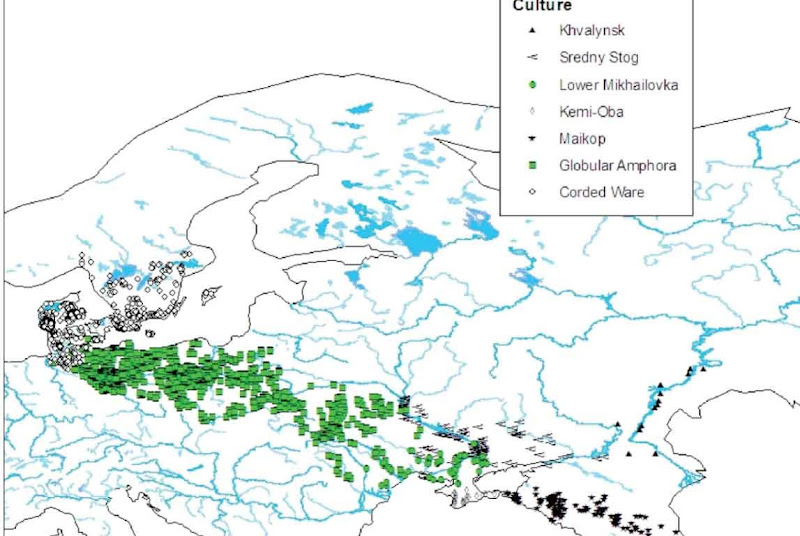
Diachronic map of Eneolithic migrations ca. 4000-3100 BC
Przedstawiam dwa artykuły na ten sam temat, z których jeden został napisany przez autora poniższego komentarza:
Davidski October 2, 2017 at 3:09 am
Haha. Thanks for the comedy. Obviously, Corded Ware is not from Cucuteni–Trypillia but from Sredny Stog, which now looks a very good bet for the Proto-Indo-European homeland and had nothing to do with Uralics. Time for another revision of your great work. Haha.
No właśnie… Zwróćcie uwagę na tzw. domieszkę stepową, czyli niby pochodząca od niby późnego PIE z Yamna / Yamnaya, czyli ulubione tzw. skałkazkie żony Davidskiego, czyli CHG + EHG lub WGH. Patrzcie na te różnokolorowe paski, a szczególnie na te żółte. Widzicie, że one pojawiają się już wcześniej niż tzw. 3000 pne na stepie pełnym Yamna / Yamnaya R1b?
Czy R1a-M417 z Sredny Stog II Alexandria na tę stepową domieszkę, to nie wiem, bo są tam widoczne 3 próbki z 15,… z których jedna jest w całości tylko EHG+ WHG, patrz:
Sredny Stog II Ukraine Alexandria [I6561 / Mos70, Skeleton 5, 88] M 5000-3500 BCE 738661 R1a1a1R1a1a1:M417:8533735G->A; R1a1a:M512:16315153C->T; R1a1a:M515:14054623T->A; R1a1:M459:6906074A->G; R1a1:Page65.2:2657176C->T; R1a:L62:17891241A->G; R1:CTS997:7132713G->A; R1:CTS2565:14366723C->T; etc H2a1a Mathieson 2017
Pozostałe dwie tę domieszką stepowa już mają… Nie wiem, co gorsze, czy to że ta jedna próbka może nie mieć szarego paska, czyli domieszki anatolijskiej / NW Anatolian, czy to że te dwie inne próbki mają już domieszkę stepową jakieś hm… 1.200 lat wcześniej od Yamna / Yamnaya…
A no i żadna z tych próbek nie jest Z93, ani J2,.. to tak przy okazji „Pra-Lewitów” i „Pra-Ario-Słowian”, ale co tam ja „biedny ruski troll” wiem… hehehe
Skoro Davidski i Amim / Atimere / Atimens / x Pietrzak zaczynają wycofywać się na nowe, z góry upatrzone pozycje, no to pewno czeka nas nawała nowych odkrywców, co to z początku z taka pewną nieśmiałością i wolno, ale jednak coraz szybciej i szybciej… podążą ich śladami… Ciekawe, że podobne twierdzenia, jak to Davidskiego można tu było przeczytać już od jakiegoś czasu… patrz:
https://skrbh.wordpress.com/?s=Yamna&submit=Szukaj
… ale co tam ja „biedny ruski troll” znam się… No dobra bogate dziewczynki i chłopaki,.. tylko mi tam wspólnie w tym tłumie nowych odkrywców wzajemnie nie zadepczcie się… Aczkolwiek wolno wam i ja wam przecie niczego nie zabraniam. A tratujcie się wzajemnie do woli,.. ale może jakby co, no to z pewną taką godnością… dostojnie i powoli… 🙂
A no i może niczego nie róbcie samodzielnie, bo jeszcze za wcześnie i znów nie daj Bóg wygłupicie się. Może lepiej poczekajcie na jakiś rozkaz albo może na jakieś z ambony kazanie,.. bo przecież sami swojego zdania nie macie, niespecjalnie szybko myślicie i ktoś inny wcześniej musi wam przecie wszystko wyraźnie napisać, co myśleć i robić… 😦
https://indo-european.eu/2017/09/new-ukraine-eneolithic-sample-from-late-sredni-stog-near-homeland-of-the-corded-ware-culture/
New Ukraine Eneolithic sample from late Sredni Stog, near homeland of the Corded Ware culture
Carlos Quiles Archaeology, Demic diffusion, Indo-European, Linguistics September 23, 2017
Just one day after publishing the draft of the Indo-European demic diffusion model, 3rd version, Mathieson et al. (2017) have updated some information in a new version of their article, including a new interesting sample from late Sredni Stog. It gives support to what I predicted, regarding the potential origin of the third Corded Ware horizon.
Czytaj dalej →







